Nose Surgery Types
7 Different Nose Types
- Short nose
- Low nose
- Deviated nose
- Droopy (long) nose
- Hump nose
- Bulbous nose
- Contracted (Upturned) nose
VIP Doctor’s Message
Successful rhinoplasty requires more than focusing on the nose alone, it demands careful consideration of harmonious facial proportions. As the central feature of the face, the nose is visually connected to the forehead, philtrum, lips, and chin. Rather than creating a uniform, conventional shape, the goal is to analyze each patient’s distinct characteristics and enhance their natural beauty.
At VIP Clinic, patient safety remains the top priority, with only the highest-quality materials and most advanced surgical techniques utilized. The ideal approach for each individual depends on various factors, including nose length, skin condition, tissue quality, previous infections, and any history of prior surgeries. VIP rhinoplasty involves a thorough analysis of these detailed factors to create a refined, elegant, and naturally voluminous result. The following are seven common nose types identified to guide the rhinoplasty process.
Operation Information
- Surgery Time : Varies
- Anesthesia Type : General Anesthesia
- Hospitalization : None
- Stitch Removal : 7 Days
- Recovery Time : 10 Days
4 Conditions for Harmonious Nose and Face
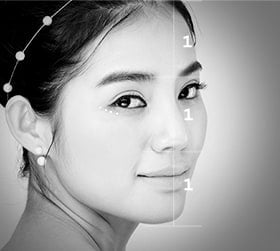
CONDITION 01 The individual ratio between the forehead-eyebrows, eyebrows-nose, and nose-chin is ideal at 1:1:1.
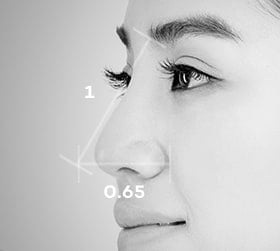
CONDITION 02 Assuming the nose length is 100, the nose height is ideal when it is ~65% of the nose length.
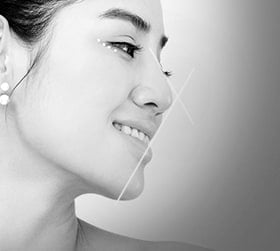
CONDITION 03 The nose tip is slightly above the nose bridge and the size should be harmonized with the chin size.
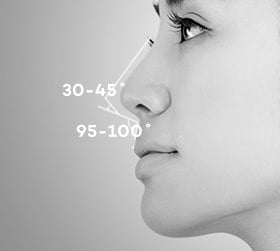
CONDITION 04 The angle between the columella and philtrum is 95–100 degrees and the angle between the columella and nose tip is 30–45 degrees for a harmonized nose.
Nose Surgery Methods for 7 Different Nose Types
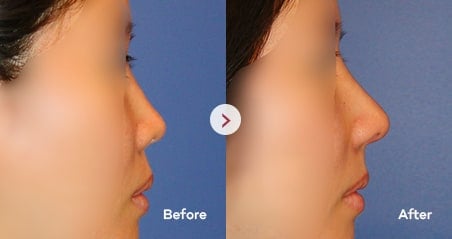
About ‘Low Nose’ A low nose tends to create a flatter, broader facial appearance due to the lack of central projection. The primary goal of surgery is to add height and enhance nasal structure. However, one of the most common reasons for revision rhinoplasty is the use of foreign implants extending from the bridge all the way to the tip – over time, these implants can cause complications such as skin reddening, thinning, or contraction, resulting in a “piggy nose” or pinched appearance. The safest approach involves using autologous tissues to elongate and project the nose rather than relying solely on synthetic implants. At VIP Plastic Surgery, surgeons carefully assess facial balance and individual nasal conditions to create a harmonious line flowing from the forehead through the glabella, nose bridge, nose tip, philtrum, and lips. Low Nose Distinct Characteristics
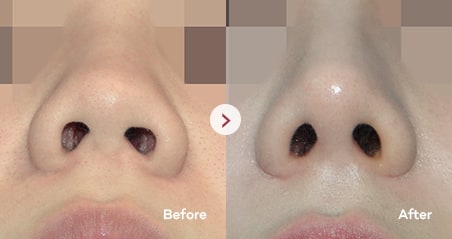
About ‘Deviated Nose’ Nasal deviation typically occurs congenitally or as a result of physical trauma during adolescence. This condition affects the nasal bone, lower cartilage, and septal cartilage, all of which must be precisely analyzed to determine the optimal combination of surgical techniques. The challenge with a deviated nose lies not only in its aesthetic asymmetry but also in the functional problems it creates, often causing breathing difficulties and discomfort. Dr. Lee Myung Ju presented the first academic paper on ‘Septoturbinoplasty’ in Korea in 2007. VIP’s Septal Deviation Rhinoplasty delivers exceptional aesthetic and functional results in a single procedure by maximizing the use of septal cartilage – whereas traditional methods required two separate surgeries to achieve these goals. Deviated Nose Distinct Characteristics
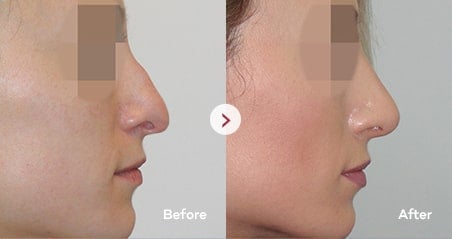
About ‘Droopy (Long) Nose’
A droopy or long nose, commonly referred to as a ptotic nasal tip, is one of the most frequent concerns prompting patients to seek rhinoplasty. The primary issue lies in the elongated nasal tip, typically caused by weak cartilage structures. Rhinoplasty can create a softer, more refined appearance by adjusting both the length and shape of the nose. An important consideration is nostril visibility, most individuals with a long, droopy nose show little to no nostril from the front view, which should be corrected to achieve balanced facial proportions. During surgery, the extrinsic and intrinsic aspects of the lower lateral cartilages must be carefully reshaped to prevent recurrence of the drooping. The angle between the columella and philtrum also requires precise adjustment, and in some cases, the muscle within the columella may need to be released depending on the patient’s condition.
At VIP, droopy nose rhinoplasty focuses on reconstructing the lower lateral cartilage and columella structures – the primary causes of the ptotic appearance. The nose bridge and base are strongly supported to fundamentally restore balanced nasal length. Droopy (Long) Nose Distinct
Characteristics
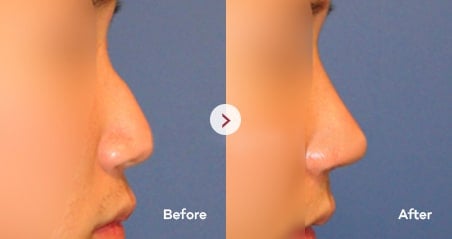
About ‘Hump Nose’ A hump nose is characterized by a protruding nose bridge, wide nasal bones, and a droopy tip. One of the defining features is weak, uneven septal cartilage beneath the nose, which contributes to the hump formation. The surgical approach depends on the severity of the deviation and prominence of the hump. In more severe cases, structural deformities of the nasal bone, septal cartilage, and surrounding muscles can cause functional problems such as chronic rhinitis. For this reason, hump nose correction is not a simple procedure of shaving down the bump and adding implants, but it requires precise diagnosis of the underlying causes before determining the appropriate surgical method. Depending on the individual case, osteotomy, structural cartilage reshaping, and septal cartilage correction may all be necessary to eliminate the hump and create a smooth, refined nasal profile. Hump Nose Distinct Characteristics
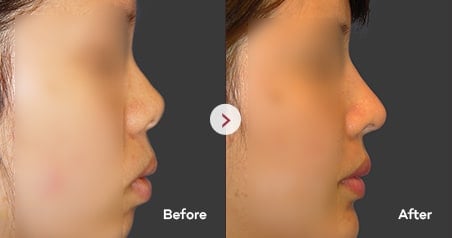
About ‘Short Nose’ A short nose is characterized by its reduced length and visible nostrils, commonly described as a “piggy nose.” Short nose rhinoplasty is considered one of the most challenging procedures, as it must address both nasal length and height simultaneously. Foreign implants are not recommended for this nose type due to the high risk of complications such as skin reddening, contraction, and thinning. The preferred materials are autologous cartilages, including septal and rib cartilage. However, harvesting septal cartilage requires exceptional expertise, obtaining an adequate amount while preserving enough structure to prevent collapse is particularly difficult in a short, small nose. The short nose is a common characteristic among Asian and African American cases. Short Nose Distinct Characteristics
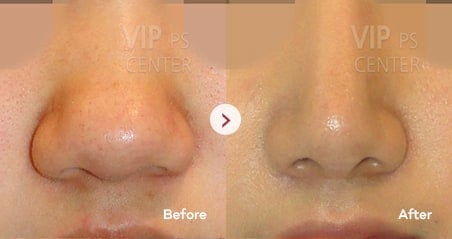
About ‘Bulbous Nose’ A bulbous nose is one of the most common characteristics of the Asian nose, prompting many patients to consider rhinoplasty. This condition typically develops for several reasons. When patients have excess fibrofatty tissue at the nasal tip, partial removal of these soft tissues can create a slimmer appearance, though conservative excision is essential to avoid an unnatural result. Another common cause is thick nasal skin itself; patients with thicker skin tend to have rounder nose tips compared to those with thinner skin. When desired, alar reduction may be performed to achieve narrower nostrils. However, many patients are unaware that alar reduction is irreversible—once performed, it cannot be undone. For this reason, careful consideration is crucial before proceeding with this procedure. Bulbous Nose Distinct Characteristics
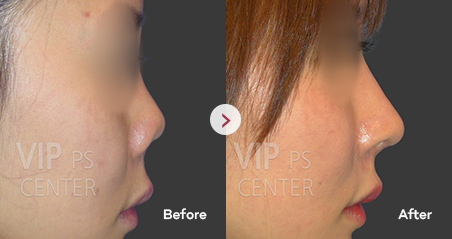
About ‘Contracted (Upturned) Nose’ When contraction occurs due to implant complications, the nose becomes severely upturned and the nostrils become excessively visible. Several factors can cause these complications, though most cases result from adverse reactions to foreign implants. When the body does not tolerate the implant well, the internal nasal tissues gradually tighten and contract, ultimately shortening the nose length. For revision surgery, complete removal of all foreign implants is essential to prevent further complications, followed by building a strong supporting structure at the nasal base. In severe cases, restoring proper length and structure takes priority; additional height can then be considered using autologous tissue. Common Reasons for Revision Rhinoplasty
Post-operative Care
Related Surgeries
Why Choose VIP?
Meet the Chief Surgeon: Dr. Myung Ju Lee
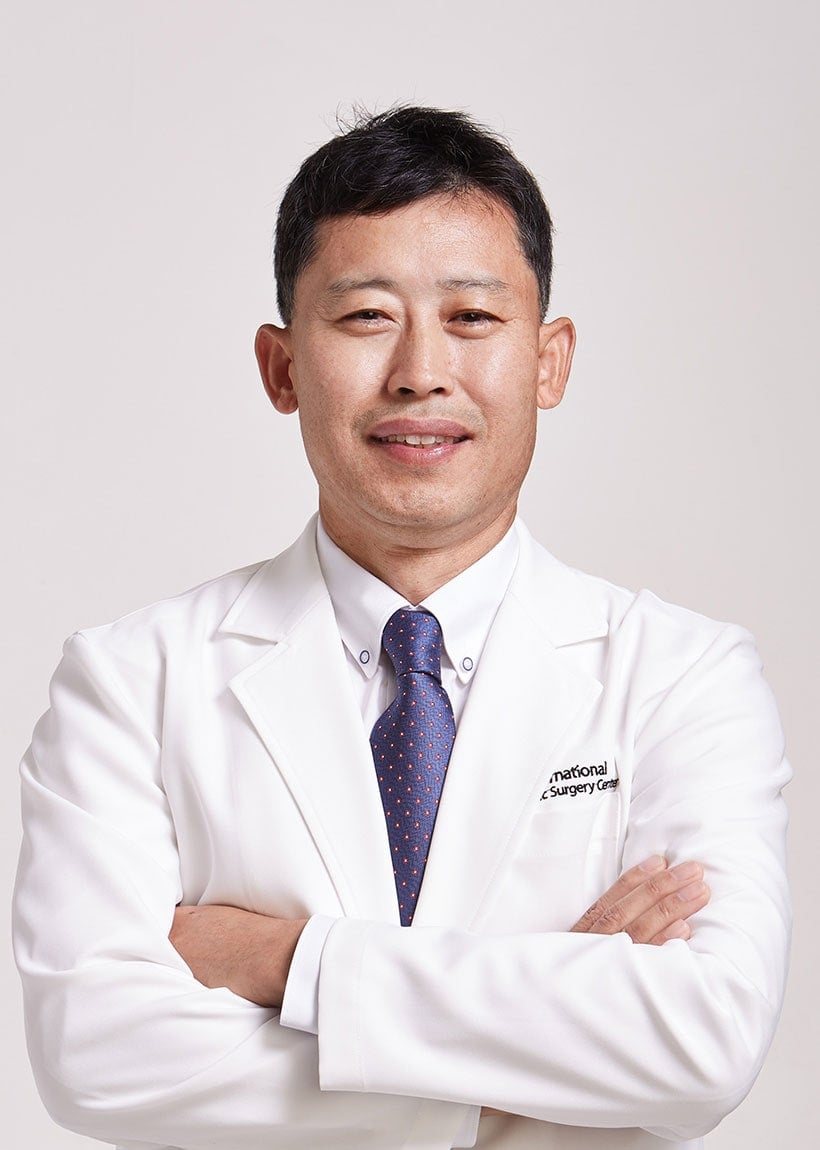
Dr. Myung Ju Lee is the chief surgeon at VIP International Plastic Surgery Center. He has been dedicating himself in the field of plastic surgery as a professor, researcher, and surgeon for more than 29 years now. As a faculty member of the International Society of Aesthetic Plastic Surgery and the American Society for Aesthetic Plastic Surgery, he has continuously devoted himself to share his techniques and knowledge. Dr. Lee is an eminent surgeon recognized for his gifted surgical techniques, especially in rhinoplasty (nose job) and anti-aging surgeries. For decades, many international patients from Asia, the United States, and Europe have visited our clinic to receive surgical procedures; VIP clinic and his reputation is ever becoming strong and solid. Read more about Dr. Lee’s academic achievements and surgical expertise.

References
- Myung Ju Lee, MD, PhD, Hyung-Min Song, MD, MS. Asian Rhinoplasty with Rib Cartilage. Semin Plast Surg. 2015;29(4):262–268.
Available at: PMC – Asian Rhinoplasty with Rib Cartilage (2015) ↗ - Myung Ju Lee, MD, PhD (South Korea). Contracted Nose Correction with Autologous Rib Cartilage Grafting.Presented at: The 24th ISAPS Congress, Miami, Oct 31–Nov 4, 2018.
Available at: ISAPS Miami 2018 – Official Congress Program (PDF) ↗ - Park CW, Choi WY, Lee MJ. Autologous Rib Cartilage Rhinoplasty for Harmonious Asian Face: Combining an Extended Columellar Strut Graft with a Pair of Maxillary or a Premaxillary Graft. Plast Reconstr Surg Glob Open. 2018 Sep 26;6(9 Suppl):107–108.
Available at: PMC – Autologous Rib Cartilage Rhinoplasty Study (2018) ↗ - Jung DW, Lee MJ. Harvesting the Entire Seventh Costal Cartilage for Secondary Rhinoplasty. Plast Reconstr Surg Glob Open. 2022 Sep 20;10(9):e4510.
Available at: PMC – Harvesting the Entire Seventh Costal Cartilage for Secondary Rhinoplasty (2022) ↗ - Choi WY, Park CW, Lee MJ. Simultaneous Breast Augmentation and Rib Cartilage Harvest for Rhinoplasty Using a Single New Inframammary Fold Approach. Plast Reconstr Surg Glob Open. 2018 Sep 26;6(9 Suppl):14–15.
Available at: PMC – Simultaneous Breast Augmentation & Rib Cartilage Harvest (2018) ↗ - Cheol Woo Park, Myung Ju Lee, Yun Ik Jung. Photogrammetric Facial Analysis of Attractive Celebrities Using the Glabella for Planning Rhinoplasty and Analyzing Surgical Outcomes. Arch Aesthetic Plast Surg. 2018 Oct 31;24(3):105–110.
Available at: AAPS Journal – Photogrammetric Facial Analysis Study (2018) ↗ - American Society of Plastic Surgeons (ASPS). Rhinoplasty (Nose Surgery).
Available at: ASPS – Plastic Surgery: Rhinoplasty ↗ - Myung Ju Lee, MD, PhD (South Korea). Rib Cartilage Rhinoplasty for the Harmonious Asian Face.Presented at: ISAPS World Congress 2016, Miyakomesse, Kyoto, Japan.
Available at: ISAPS World Congress 2016 – Official Program (PDF) ↗

















